Aged 15 years, 09 months & 25 days, Emre Demir became the youngest ever goalscorer in the Turkish Süper Lig in 2019, beating the previous record held by Enes Ünal by six months. He was already the third-youngest player to play in the league having made his debut aged just 15 years, 04 months & 04 days, so it was clear at the time he was a special player.
Demir went on to play over 500 league minutes in the 2019/20 season. Last season, he was on the pitch just over 200 minutes in the league despite his good performances in the cup, where he scored two goals in just 166 minutes. Finally, this season he hasn’t played yet, making the bench for every match so far.
Despite the hype having come down since his debut, Barcelona decided to buy Demir for two million euros and he’s expected to join the La Liga giants either in January 2022 when he turns 18 or next summer. In this tactical analysis, we’ll see what attracted Barcelona enough to anticipate teams in the EPL and get the young star.
Data analysis and profiling
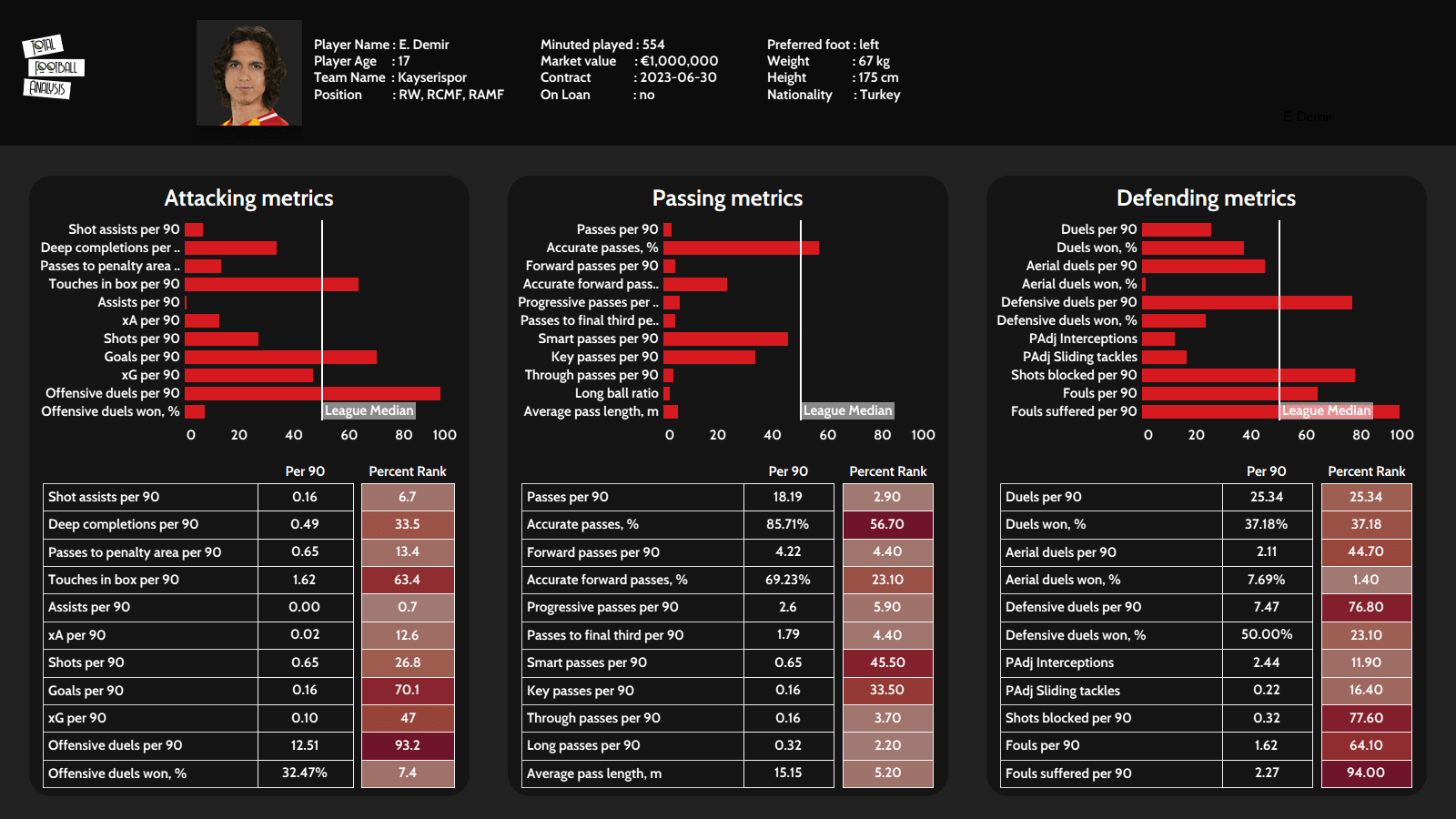
Demir is a left-footed attacking midfielder who can play in different roles depending on his team’s tactics. He’s quick and agile but weak in duels. Anyway, he seems to have a good frame and will surely get stronger with time but struggles in duels at the moment.
The data profile above is from the 2019/20 season, in which he played 554 minutes for Kayserispor’s first team, the most in a single season so far from him. To add some context, Kayserispor finished the season in the 17th position out of 18 teams and only the pandemics prevented them from being relegated so it wasn’t an easy place to shine for a 15-year-old player.
Demir got famous as the youngest ever goalscorer in the Turkish Süper Lig and there’s a reason for that. With 0.16 goals per 90, he was in the top 30% among players in his position in the league and that was backed with decent underlying numbers as his 0.1 xG and his 1.62 touches in the box per 90.
in terms of passing, Demir didn’t get many chances to prove his quality as his team was usually dominated but still managed to produce quite good numbers with 0.65 smart passes and 0.16 key passes per 90 (both between the 30th and the 50th percentiles) from just 18.19 passes per 90 (least in the league).
On the defensive side, he had great numbers in defensive duels per 90, partly because of his team being out of possession most of the time. Being quite a lightweight but with his quality on the ball, he managed to draw lots of fouls too (2.27 per 90, top 6%).
We’ll explore these characteristics further in this scout report.
Versatile but without a clear position
It’s difficult to determine Demir’s specific or best position. His heatmap below from the 2019/20 season shows a player who tends to play in the right side of the middle third but with some presence deeper in the pitch, on the left side and also closer to scoring positions.
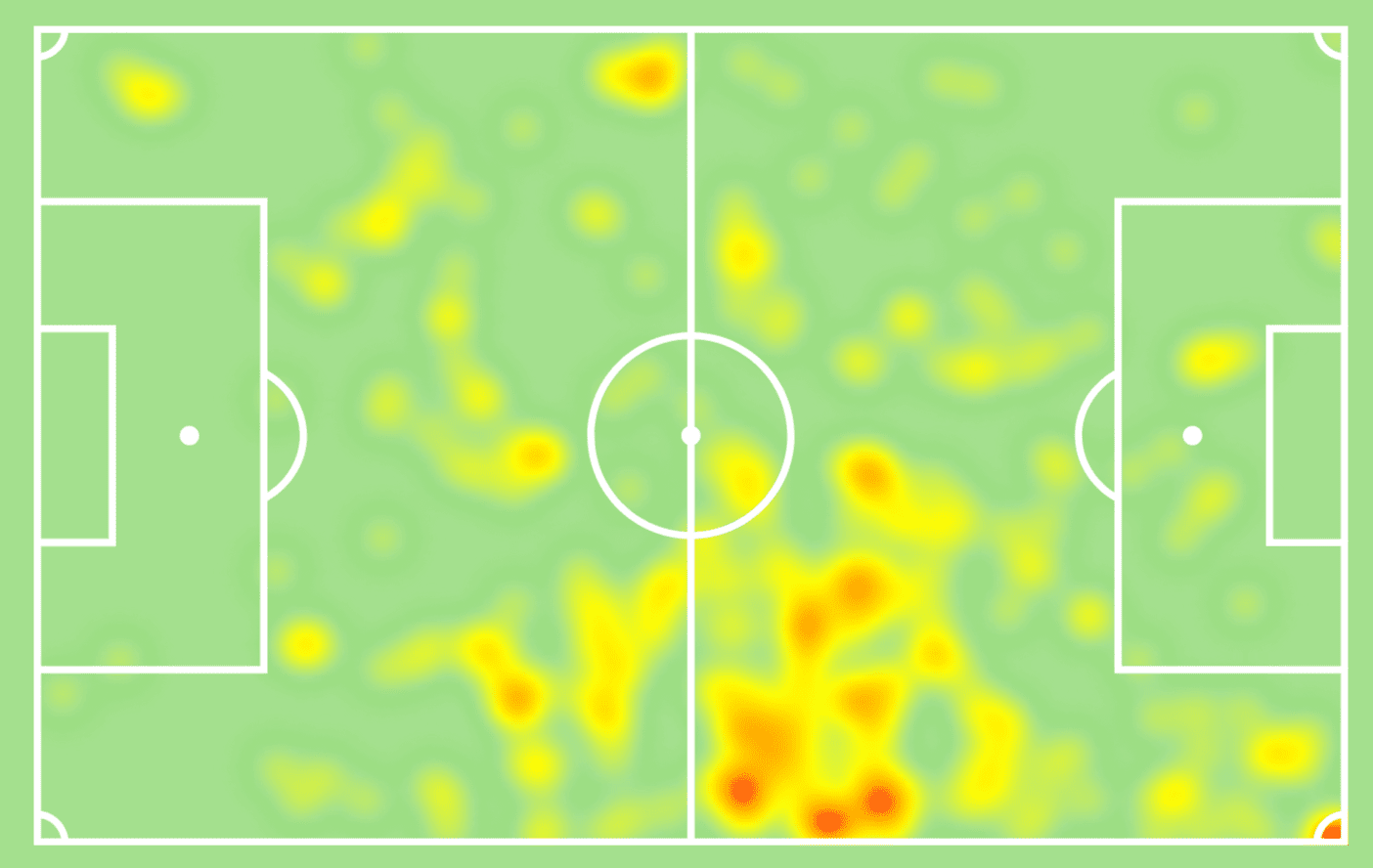
An offensive-minded midfielder, Demir fits quite well in the classical number 10 role with two central midfielders behind him in a 4-2-3-1. He has played 22% of his first-team minutes in that specific position, which implies less defensive duties and less responsibility in the ball progression.
But that central role is a very important one and 48% of the time he has played from the wings even if drifting inside and playing close to the above-mentioned 10 role, while 29% he has been deployed as a central midfielder, which is the position he would have in Barcelona’s classical 4-3-3.
He has even been part of a double pivot and at some points, has appeared as a second striker, without any defensive responsibility and very close to the box. He’s capable of running in behind and providing depth from different positions, dynamic and with a good work rate, not a winger who stays wide and waits for the ball.
A dynamic player with a fluid role
Dynamic, he’s always on the move looking to receive to his feet or into space depending on the moment of the game. In the same play, Demir occupies different positions but he does it with intelligence, attacking the spaces his teammates leave.
Demir loves to receive to his feet, pass and move. He comes deep at times but always returns to a more advanced position between the lines or in the half-spaces after releasing the ball. With these movements, he either drags rivals with him and creates space or receives the ball free from any mark.
This work rate in attack is something he shares with the new generation of Barcelona midfielders like Pedri, Gavi or Riqui Puig. Of course, he would need to adapt to Barcelona’s ‘Juego de Posición’ which is very strict in terms of which space to occupy at every moment. At his age, he still has time to learn in the B team and get ready to step smoothly into the first team if the tactics stay consistent between both.
Let’s see some examples of his movements and dynamism. In the next sequence, Demir comes deep from almost a striker position, offering his teammate the option to pass the ball to his feet. As soon as the rival defender steps out to follow him, he turns and runs into the space he has created by dragging the rival out of position and receives a dangerous pass.
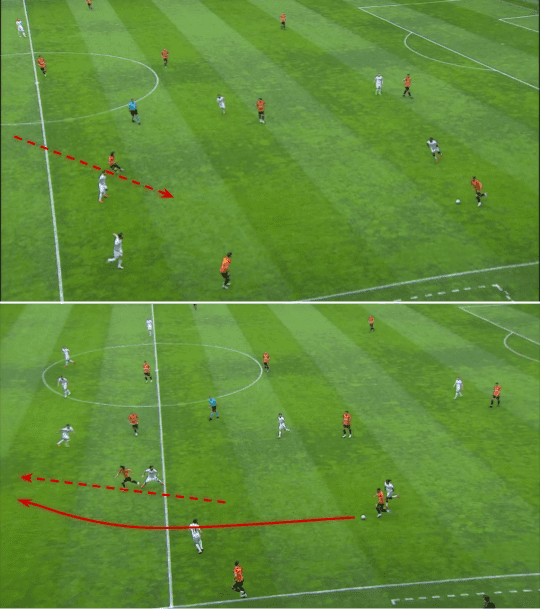
The play above shows that apart from the dynamism, there’s a sense in his movements and he can take advantage of his own decoy runs. It’s also important that he doesn’t always want the ball to his feet and can run in behind and provide depth too.
Another thing he really likes is to pass and move. Especially when he gets the ball on the right side of the pitch, he loves to play a direct pass to the striker who’s playing with his back to the goal and make a diagonal run to receive the layoff like in the picture below.
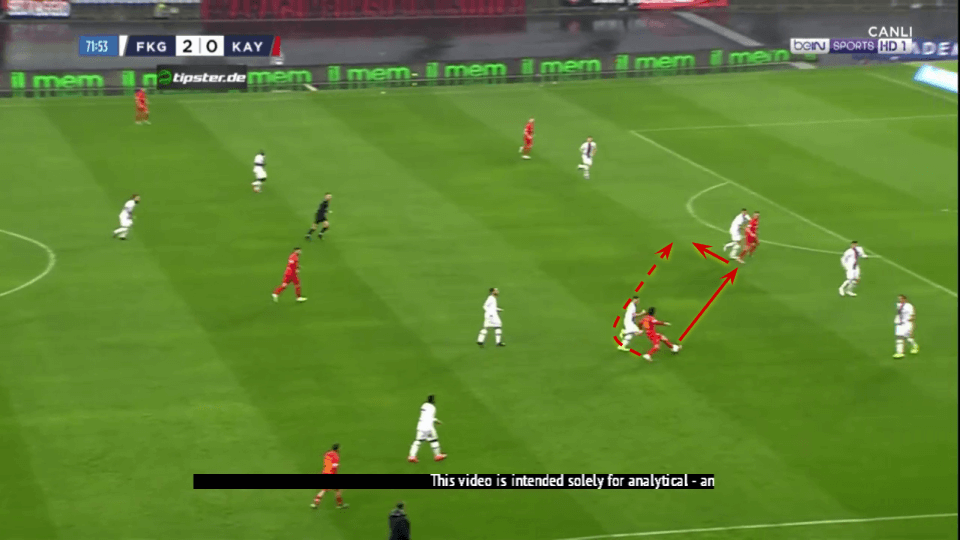
And another proof of how well he understands how to occupy space can be seen below. As his teammate leaves the centre to move wide and provide width, Demir runs into the space that has just been left free to provide depth and receive the ball. Again, he doesn’t need to receive to his feet and creates and takes advantage of spaces with his movements.
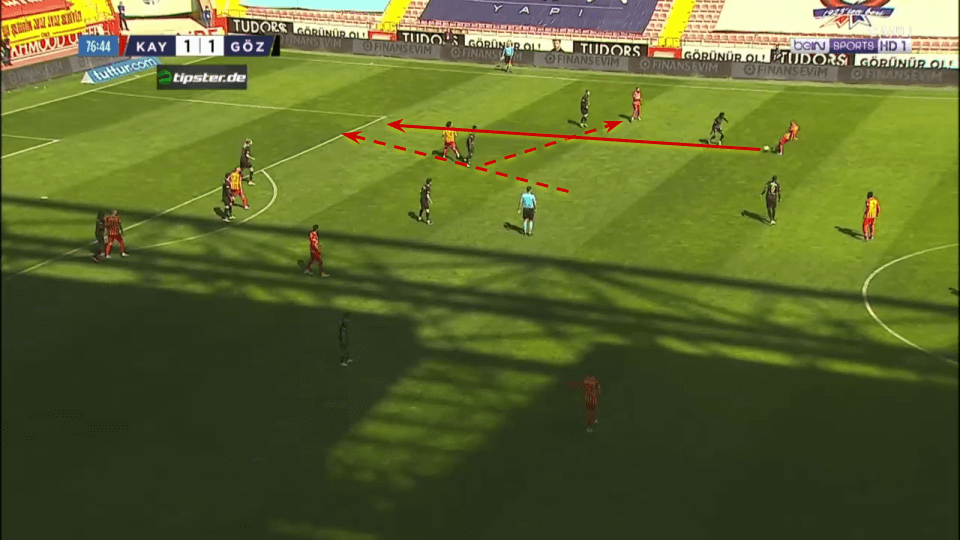
Even if his scoring figures aren’t spectacular in the minutes he has played in the first team, Demir’s dynamism and work rate mean he also gets into interesting scoring positions. He makes good late runs into the box and enjoys some good chances so we can expect him to be a midfielder who scores five or six goals a season if he plays most games.
The map below shows his shots with the first team and with the youth national teams. Playing senior football, he has into interesting scoring positions and has tried more speculative shots too but with the national team, he has shot a lot from high xG zones near the six-yard box and has also shown his quality to cut inside from the right and shoot.
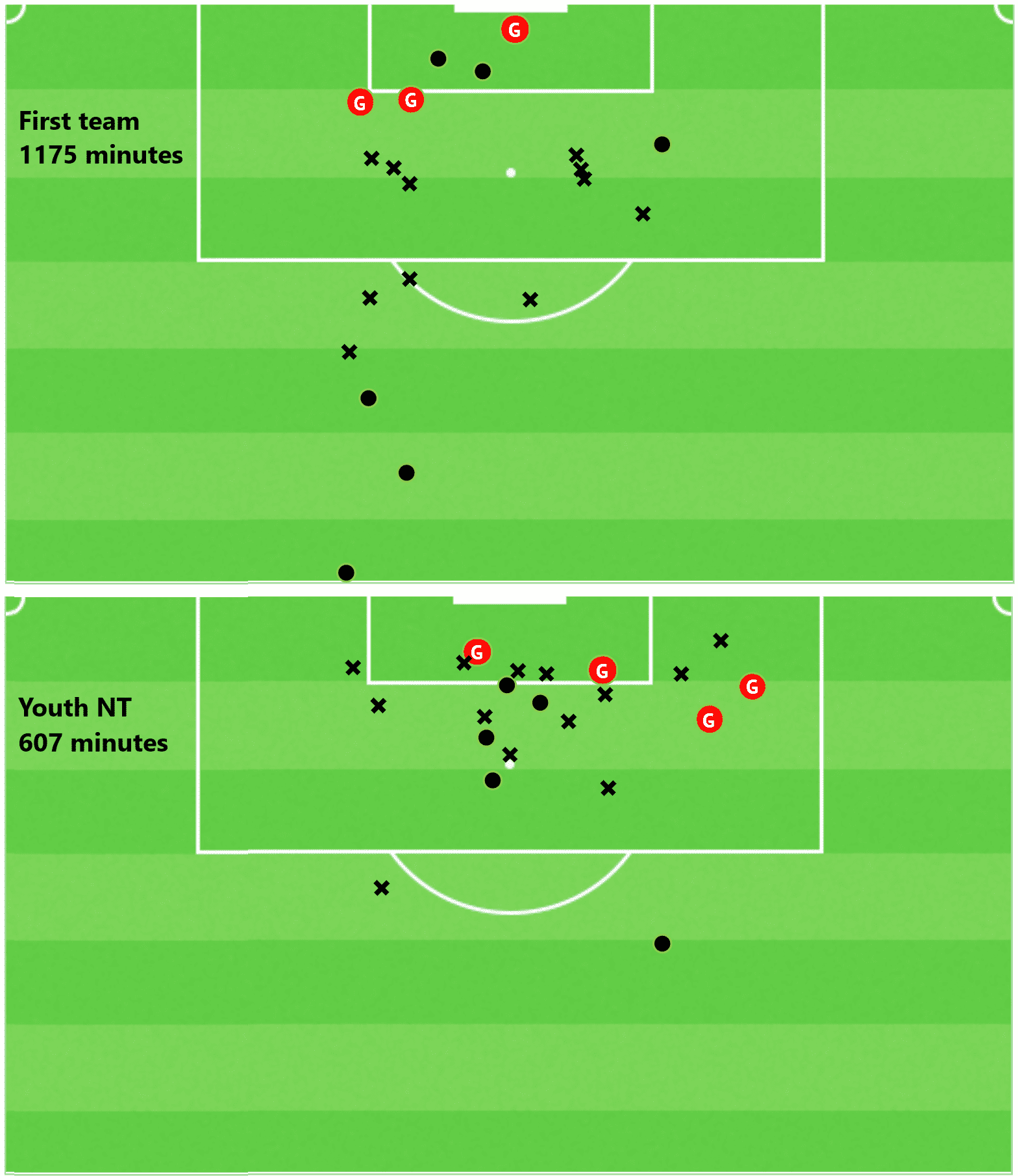
Elegant dribbler
We’ve already seen throughout this tactical analysis that Emre Demir’s end product is still not there. However, he shows glimpses of his quality which are very promising for a 2004-born player in senior football.
Demir has a great technique, using both feet to control and drive the ball forward. All his movements are smart and he doesn’t need intricate skills or any kind of showboating to get things done. Some of his first touches, especially his layoffs when receiving between the lines, and his elegance to effortlessly carry the ball at a high speed are his technical highlights but he also possesses good passing accuracy and is capable of escaping pressure in tight spaces.
On the negative side, Demir isn’t very strong and still doesn’t know how to use his body to protect the ball in some actions so struggles against bigger and older defenders. Also, some of his touches are still heavy and he makes unforced mistakes. This leads to a quite high number of lost balls, especially in the final third where it’s more difficult to find space to play comfortably.
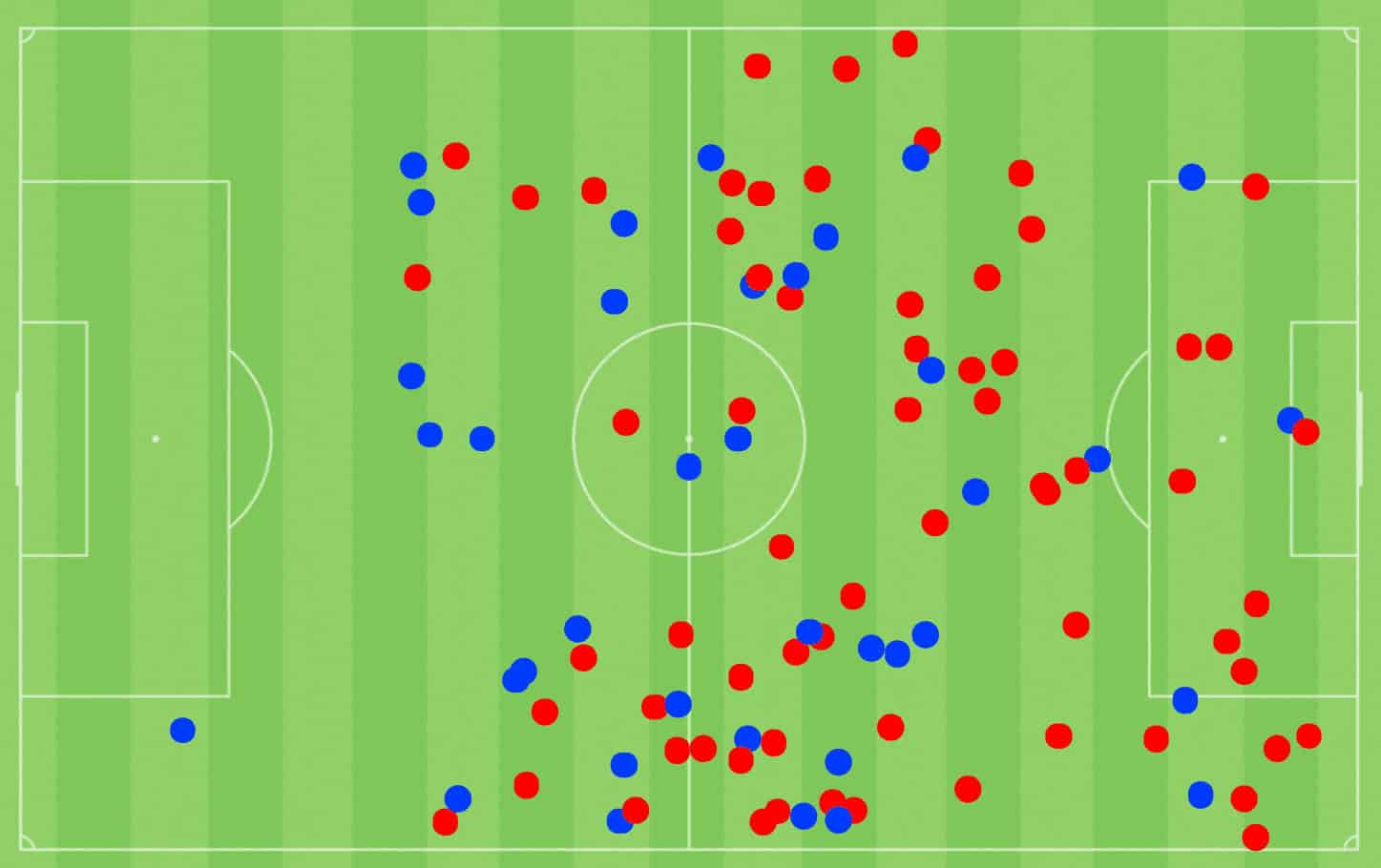
In the above map, we see Demir’s offensive duels and dribbles with the first team. It’s clear that his success rate isn’t high enough yet and he finds it difficult to keep the ball when challenges in advanced positions.
Let’s see some positive examples of Demir’s dribbling ability in different situations.
In the first one below, Demir takes the ball in his own half in an attacking transition and initiates a forward run. When a defender steps out to mark him, he feints a move to the left and cuts inside with a nice nutmeg to get into the opposition half. Despite being a quality move, we must note the spaces Demir has available when he takes the ball make it much easier to get past players and advance quickly.
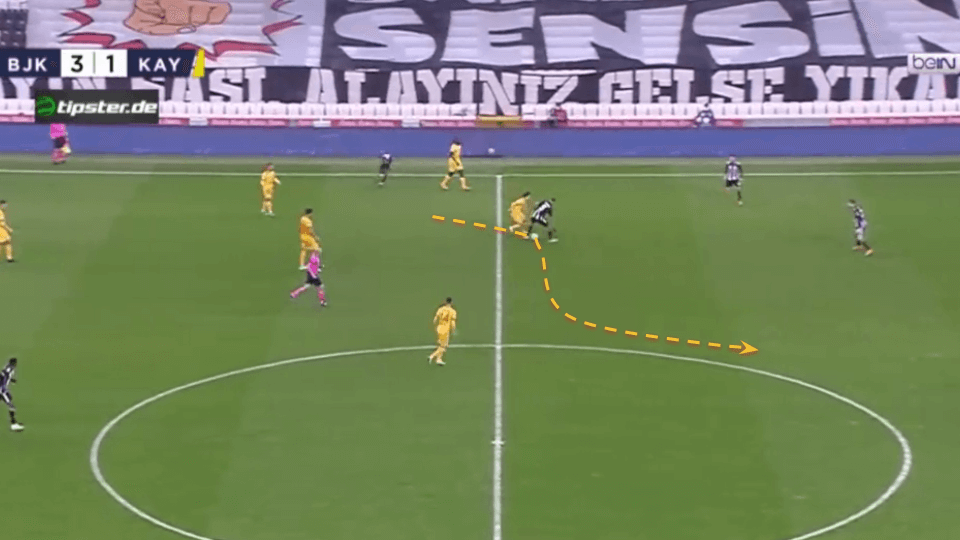
In the sequence below, we see Demir take advantage of the lack of compactness in the rival to break lines with his runs and progress into the final third. He first receives the ball from the centre-backs and lets it run across him while sending the pressing rival the wrong way with a subtle feint. Then he manages to drift past two rivals at a good speed with simple and elegant touches to then assist almost from midfield into the run of his teammate.
This sequence shows his intelligence to use space and time to his favour to glide past players and break lines. It’s positive to note he’s capable of having an impact after the runs but it’s also true that he has a lot of space to play, something he probably won’t find in La Liga.
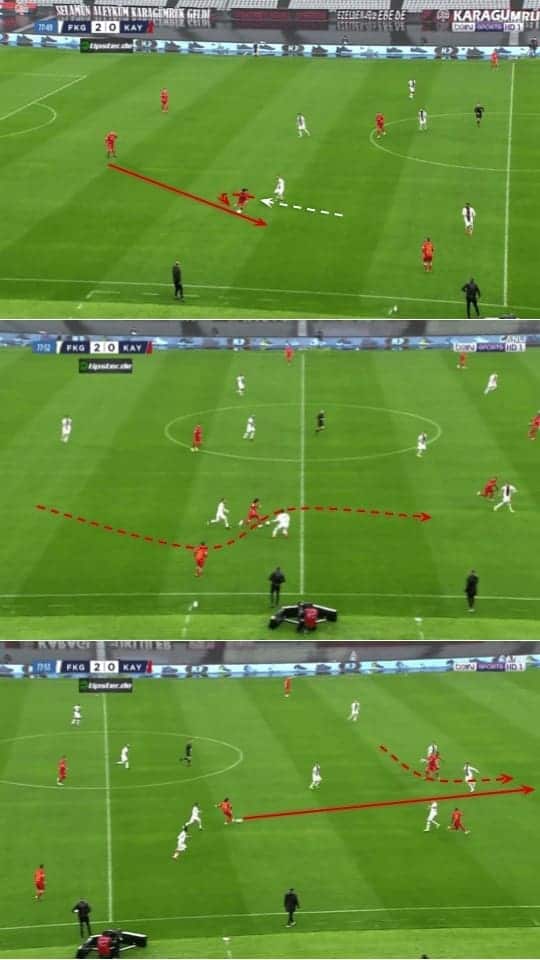
Demir has also shown the skill to play and manoeuvre in tight spaces. Even if he still looks like a teenager in duels, once he gains some momentum and is on the move he’s capable of changing directions very quickly and manipulates the ball well. His dribbles in short distances don’t create a lot yet but he’s capable of at least drawing fouls and there’s a potential to become a great player in these situations as he matures.
We have a couple of examples to understand this. In the first one below, Demir gets the ball at the edge of the box and with few but very good touches he gets between and past three players on the wing. He ends up being fouled right outside the box.
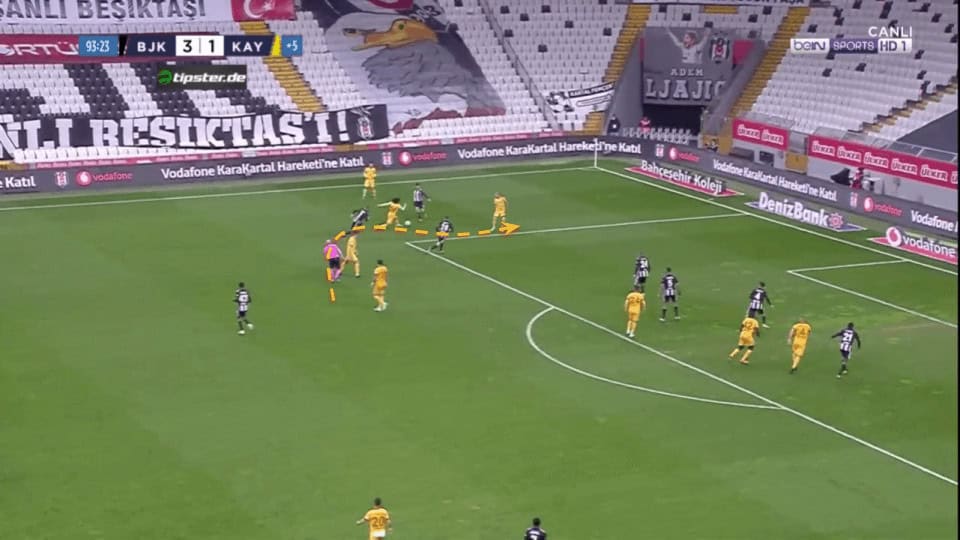
And in the last one, he gets the ball again at the edge of the box and uses the sole of his left foot to manipulate the ball and attract rivals. In the last moment, he moves the ball from his left to his right foot to get between both rivals. Again, he’s fouled before he can advance more.
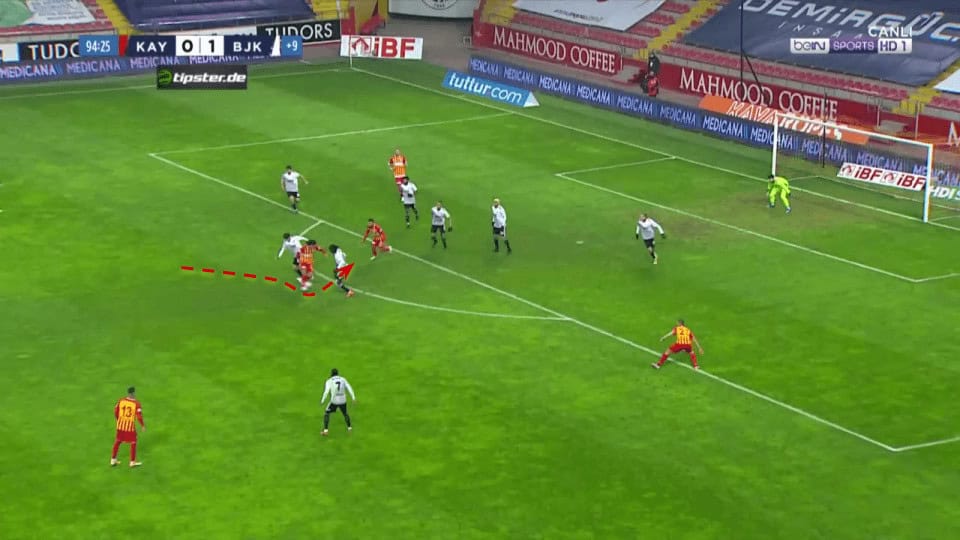
Vision and creativity
Combining his good understanding of space and time and his technique, Demir is capable of delivering some great passes both to create chances directly and to put his teammates in a good situation to do so.
Being always on the move, Demir scans a lot and knows where the players and the spaces are all the time. His overview of the pitch is very good and he looks further from the closest players and can find creative options to advance or improve the attacks.
The example below is an interesting one. In an attacking transition, Demir has two good options for a short pass but he raises his head and spots the run of his teammate on the opposite side of the field which could lead to creating a chance directly with just one pass. He then trusts his technique and hits the longer pass into the run of his teammate.
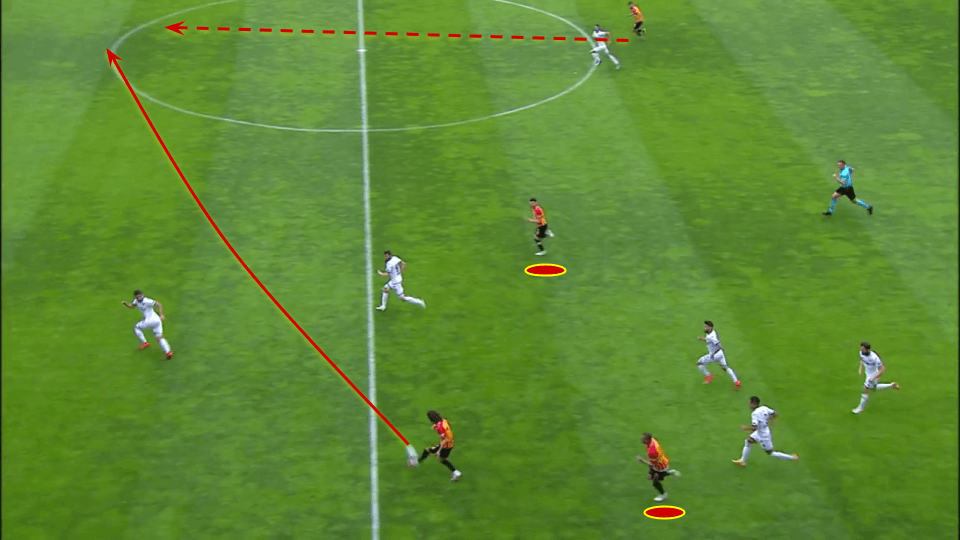
This overview of the pitch also stands out when he receives the ball between the lines. Demir usually knows what to do before receiving so he can play first-touch quality layoffs before the rivals can even press him.
In the picture below, Demir gets behind the first pressing line and receives the ball from the defensive line. As he moves, a rival leaves his wide position to mark him but Demir just needs one touch with the outside of his left foot to play a perfect no-look layoff to his teammate, who’s free after Demir has attracted the defender.
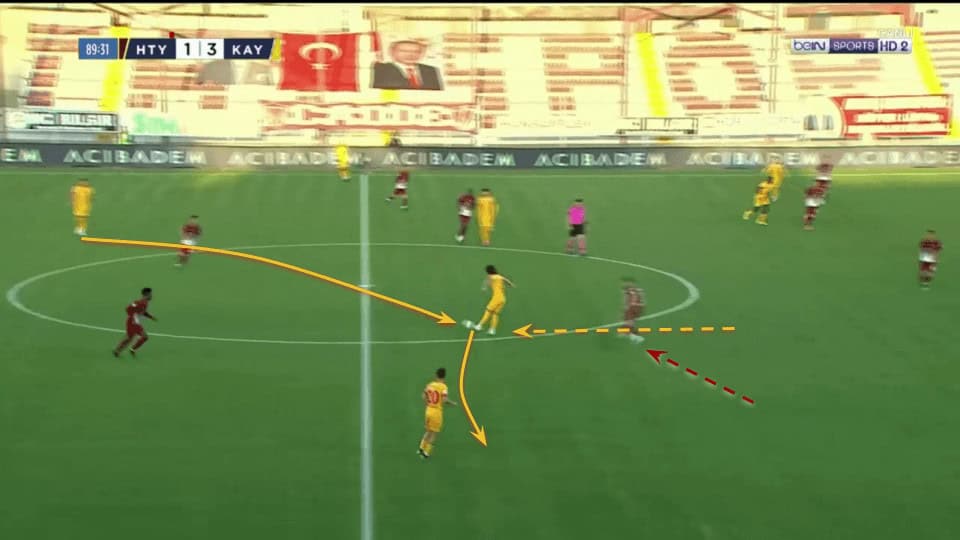
Plays like the one above in which Demir can’t even be pressed when receiving between the lines are an important part of his game as he can accelerate the attacks through the middle with just one touch.
When it comes to translating all this vision and passing quality into assists and chances, Demir has shown some promising details. In the map below, we see his key passes and passes into the box for Kayserispor so far.
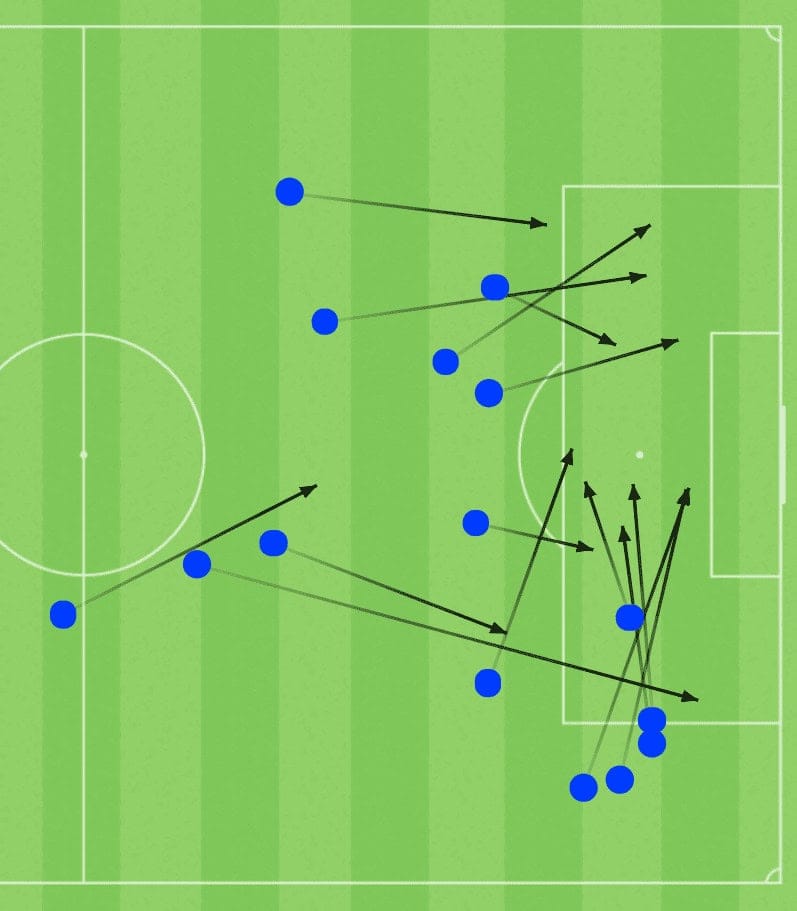
There are two different areas to consider. When playing on the left side of the pitch, Demir has the quality to pass the ball into dangerous positions from further away, mostly because he doesn’t have as many chances to dribble or shoot from there. When on the right, he appears wider and clsoer to the box, from where he can cut inside and play short passes to assist.
Below, we see one example of his quality to assist. Running with the ball at his feet from the left side, Demir doesn’t have many options to dribble or shoot as it would imply cutting inside to his weak right foot. With his teammate running in behind in front of him, he carries the ball until the defender needs to make a decision and then releases it at the right moment to create a chance.
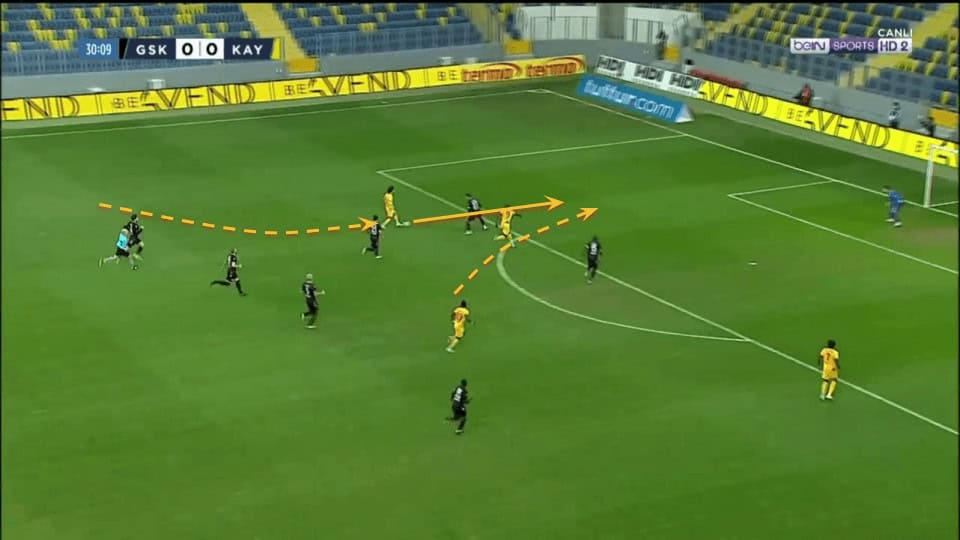
Conclusion
Emre Demir is still a very young player. Obviously talented but inconsistent and with plenty of things to develop. The glimpses of quality he has shown in different areas of the game and his dynamism are exciting for a 17-year-old and more than enough to consider him a good piece of business at just two million euros.
Once he arrives in Barcelona, he’ll have the challenge of establishing himself first in the B team and then in the first team. Lots of players have failed to make the step like Konrad De La Fuente (now in the Ligue 1 with Marseille) or Carles Pérez (now in the Serie A with Roma) but if he understands Barcelona’s tactics and continues his growth path, he’ll surely be one to watch in the next few years.





Comments